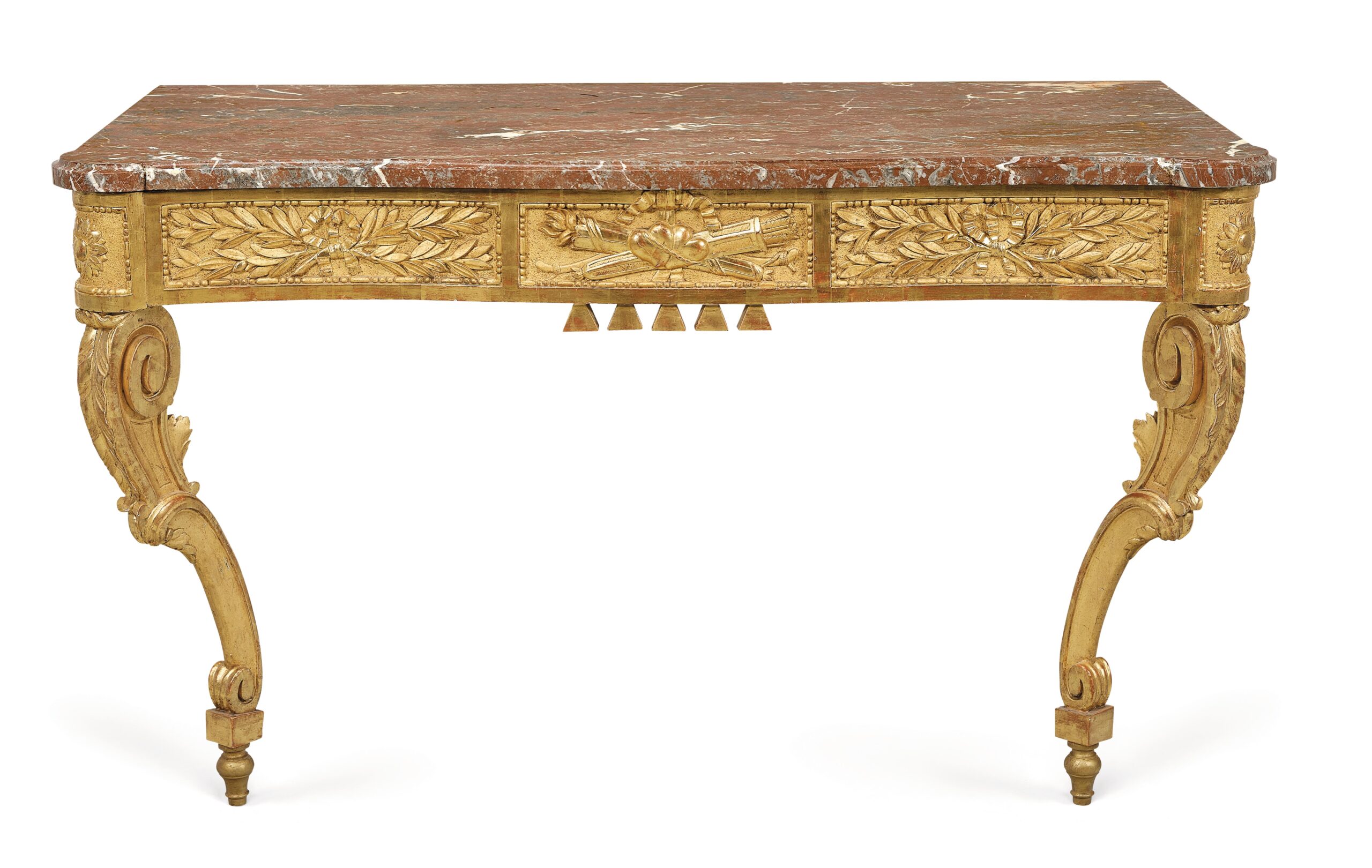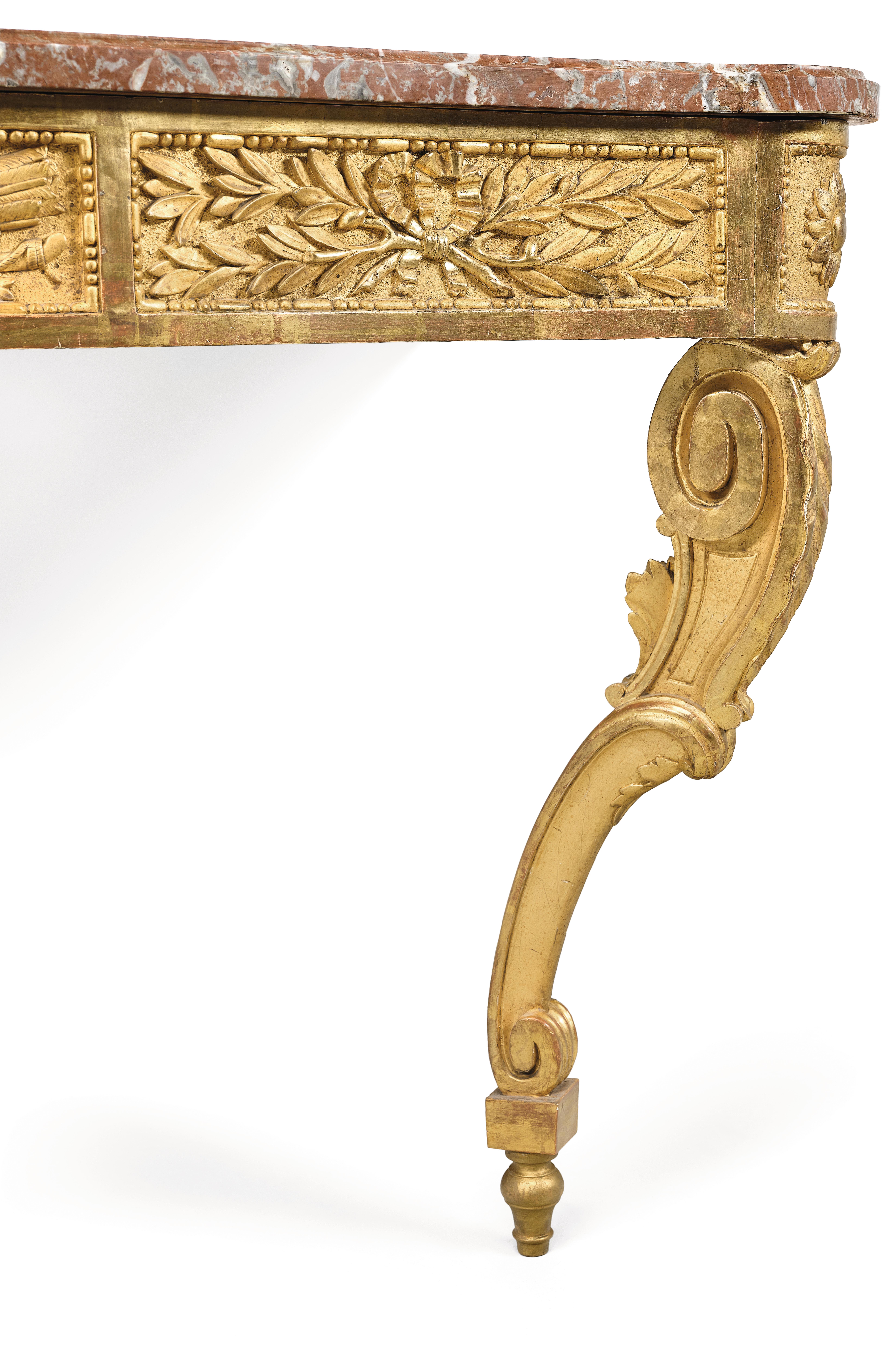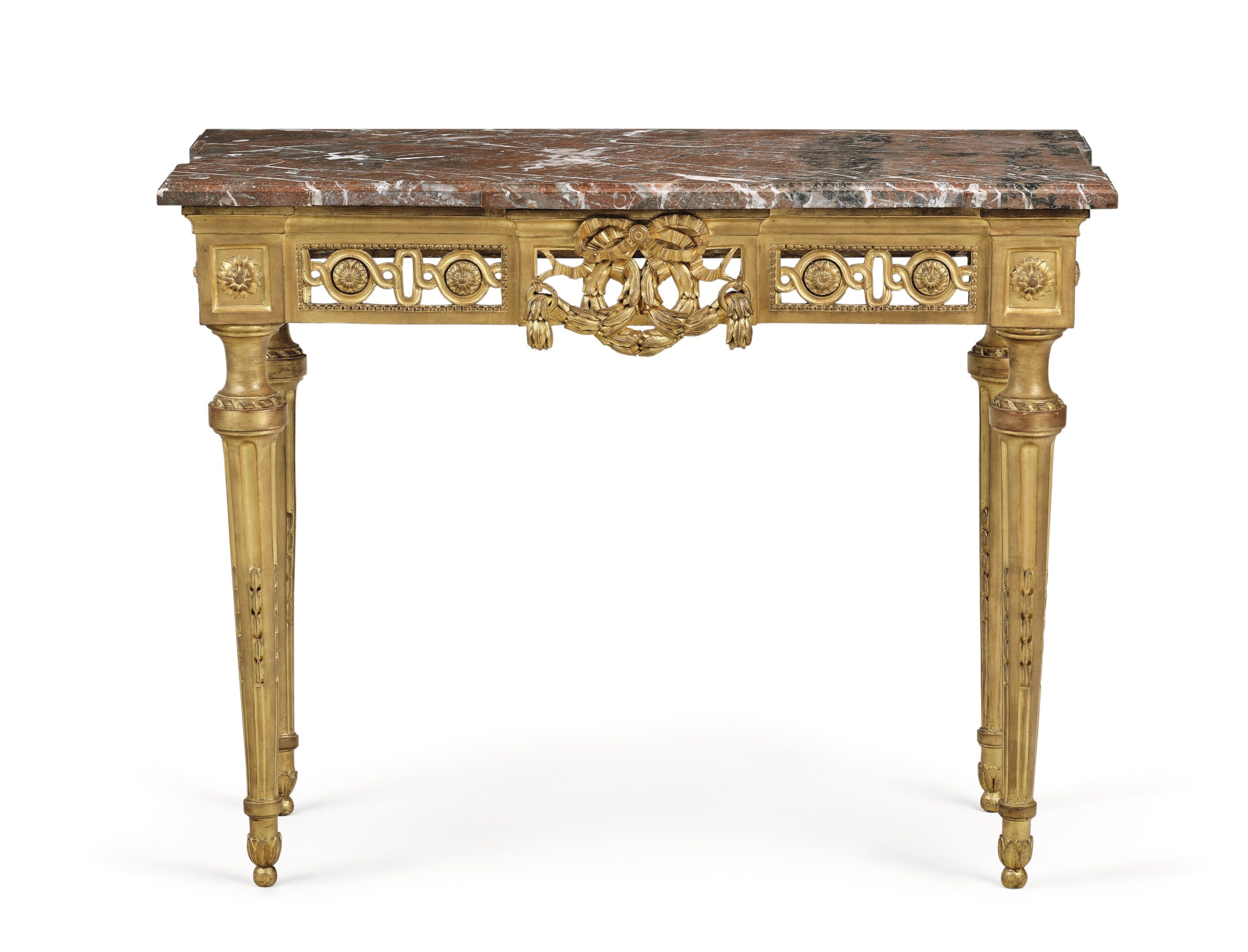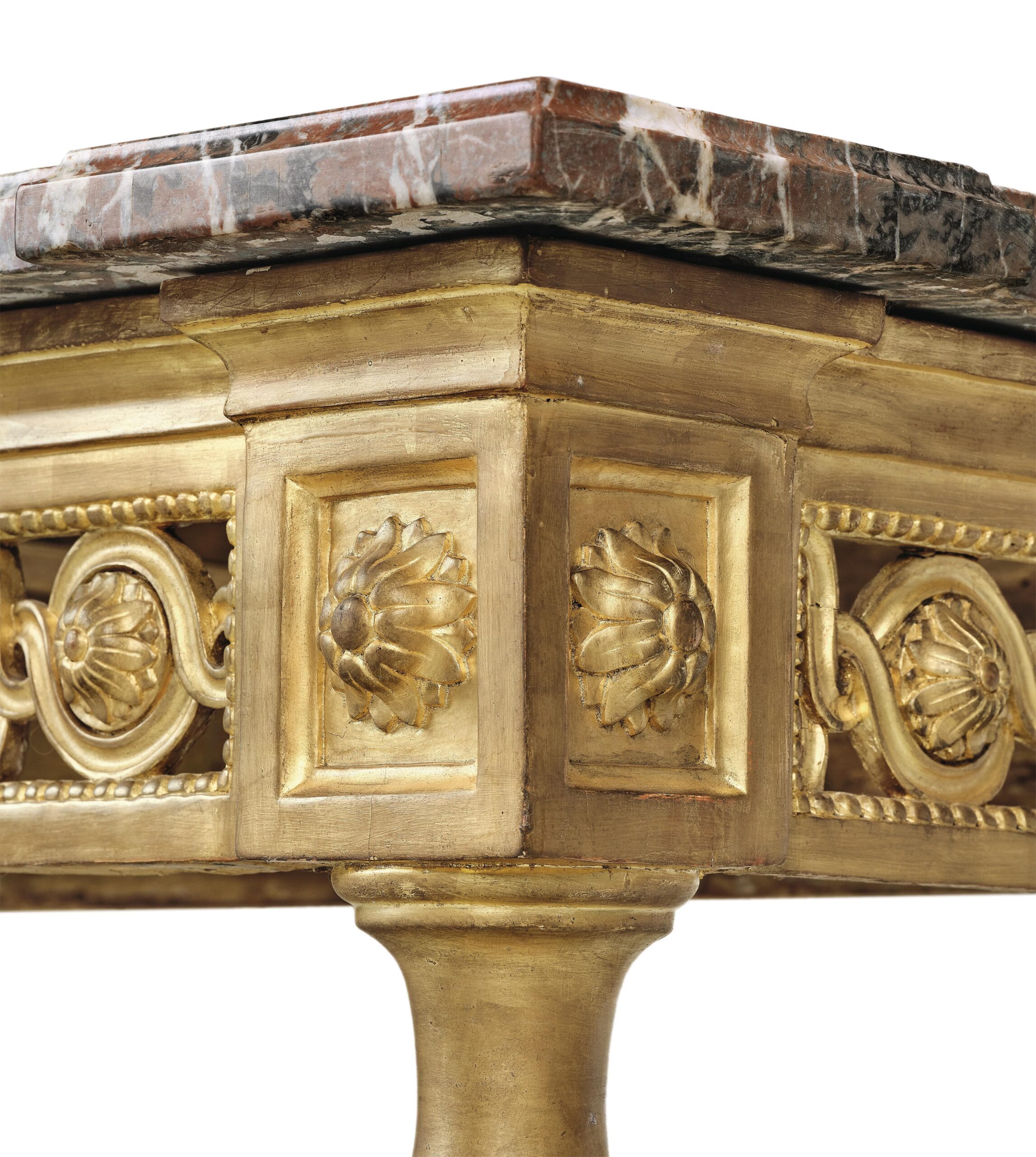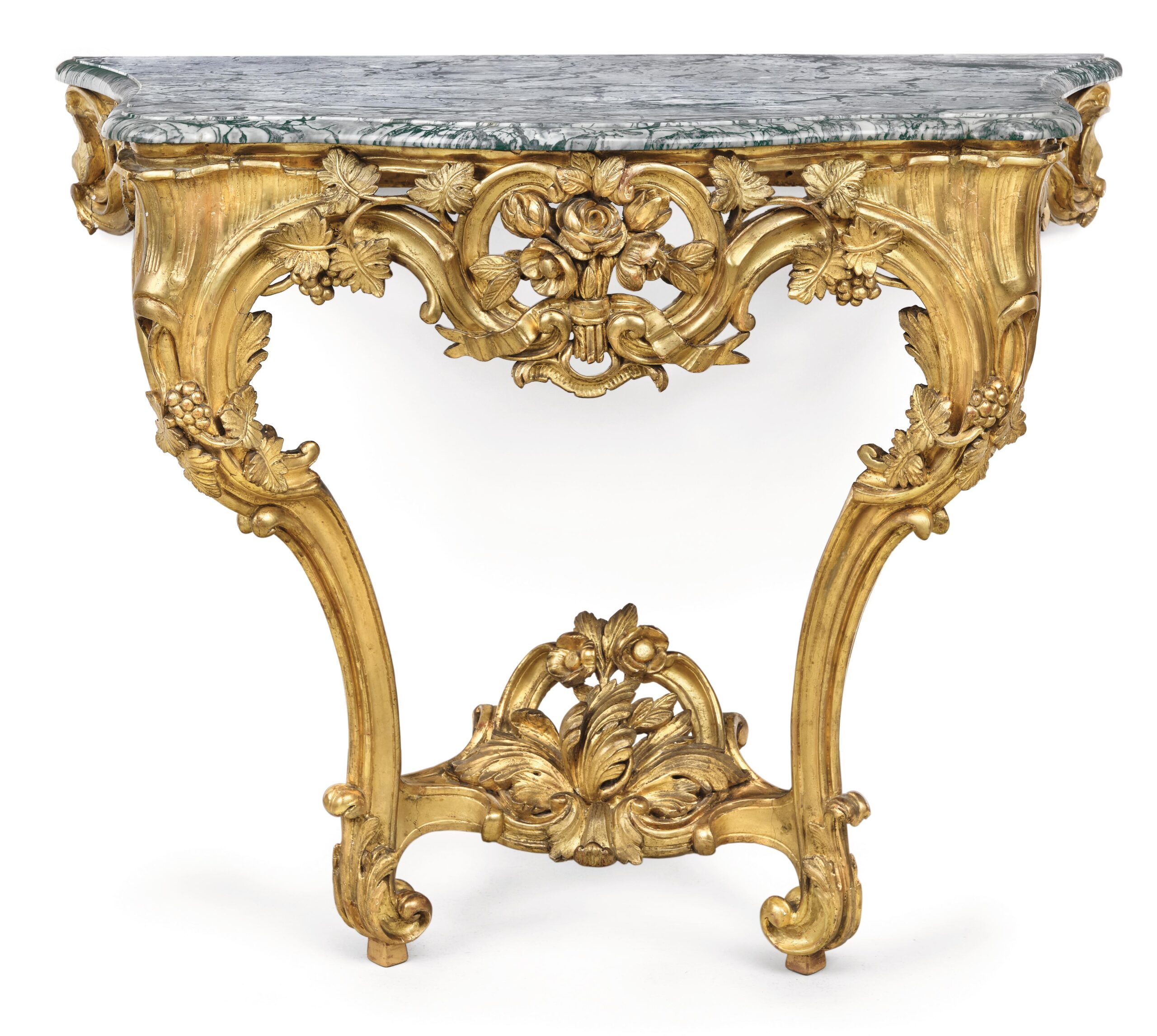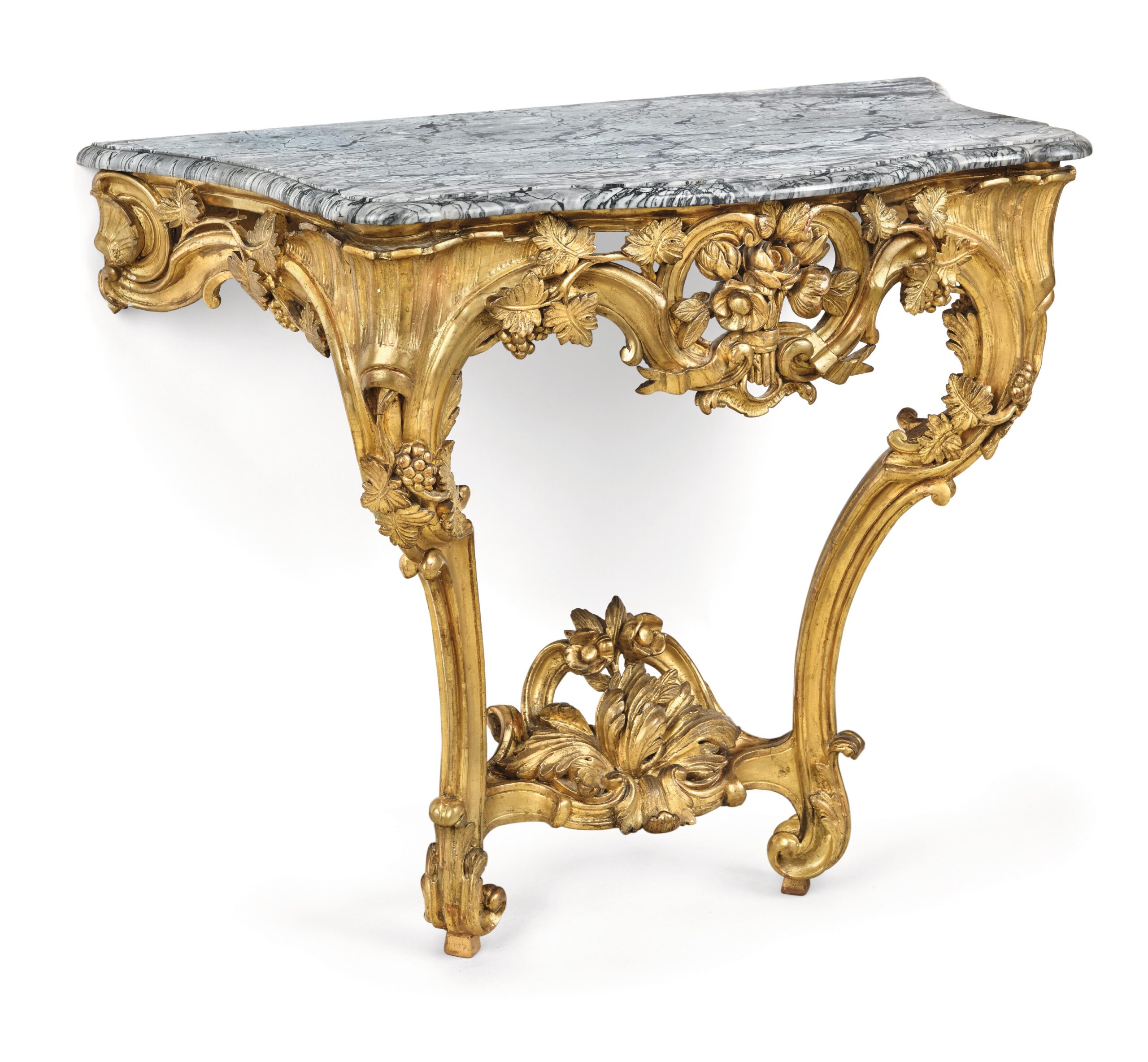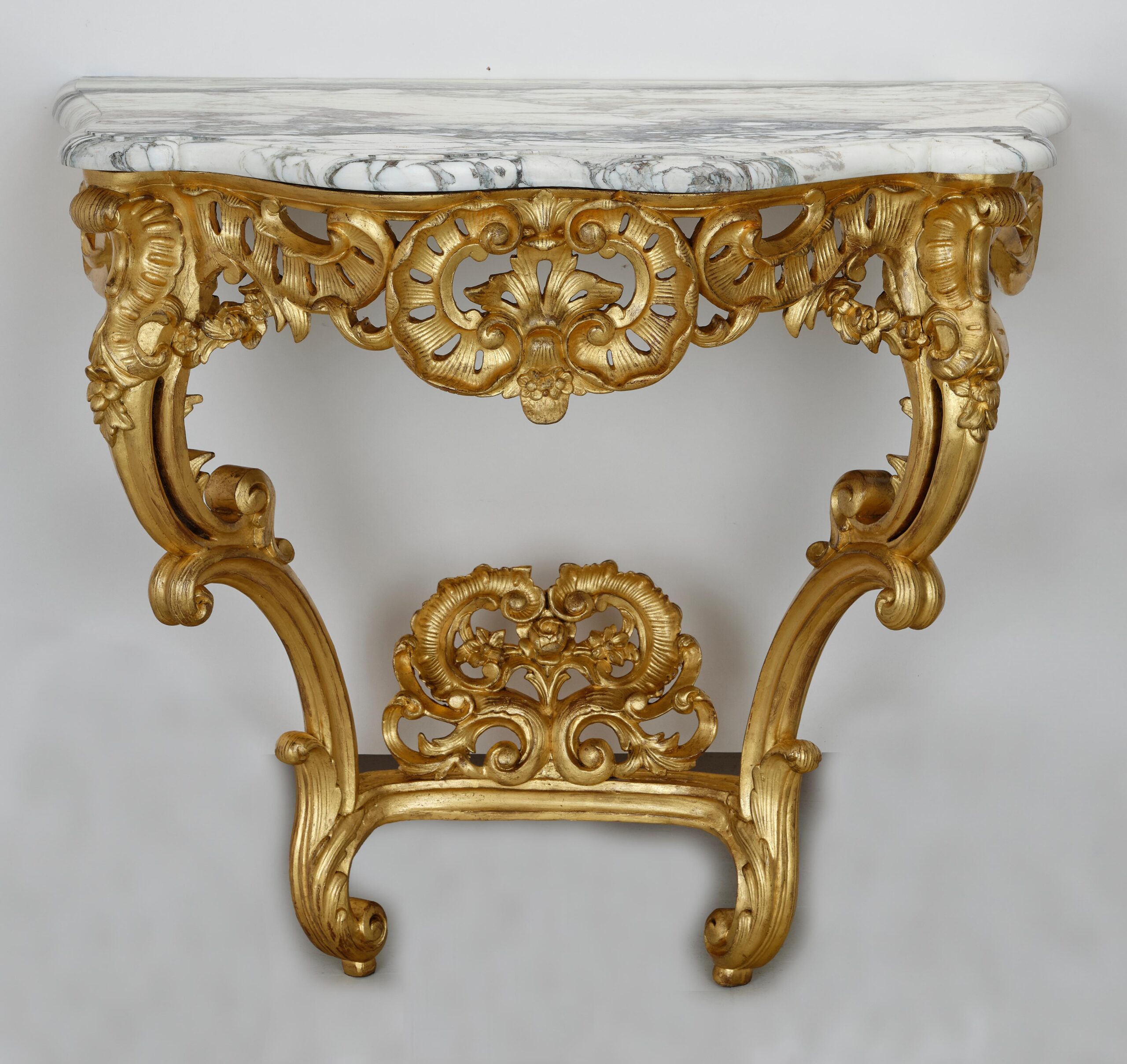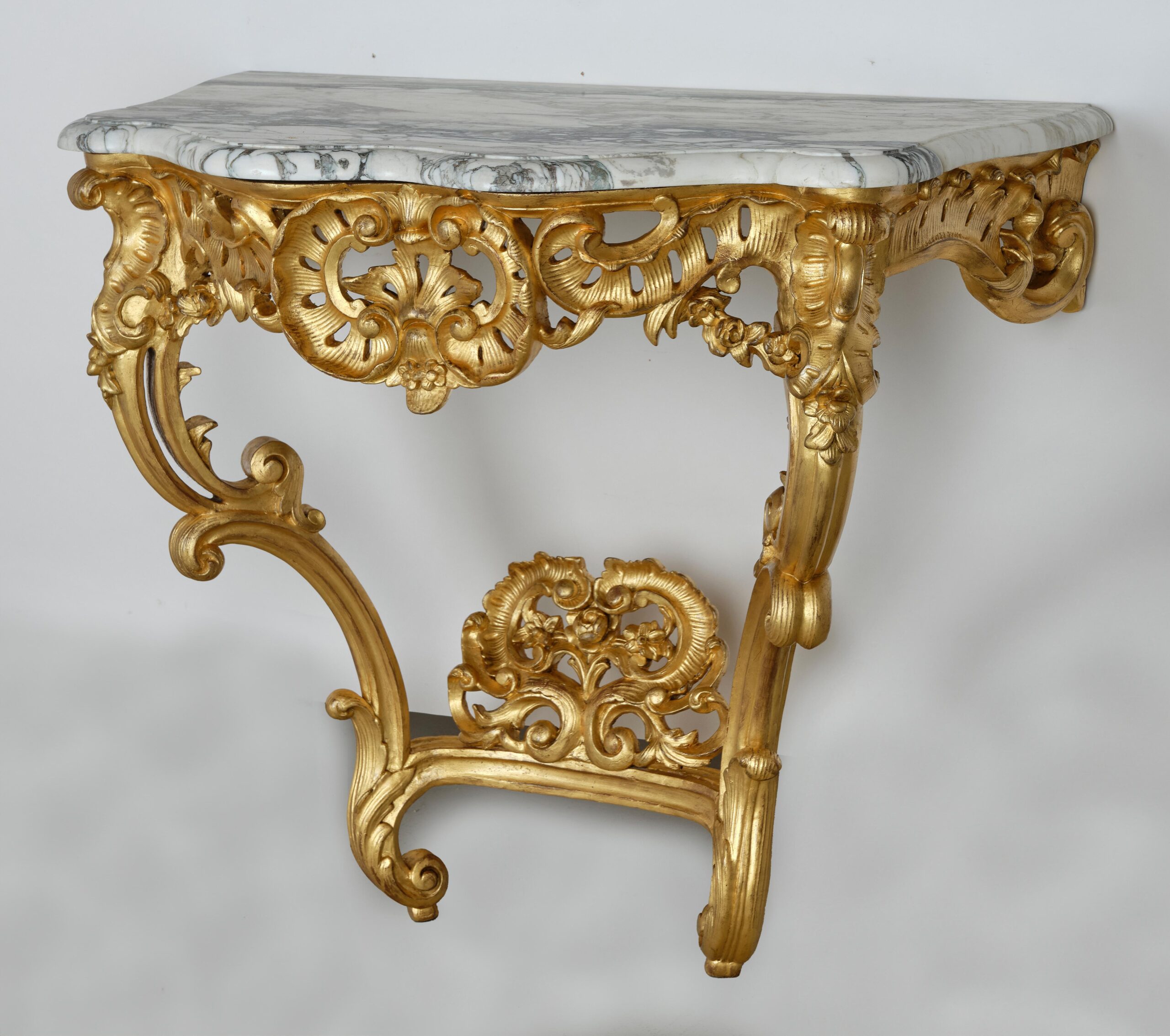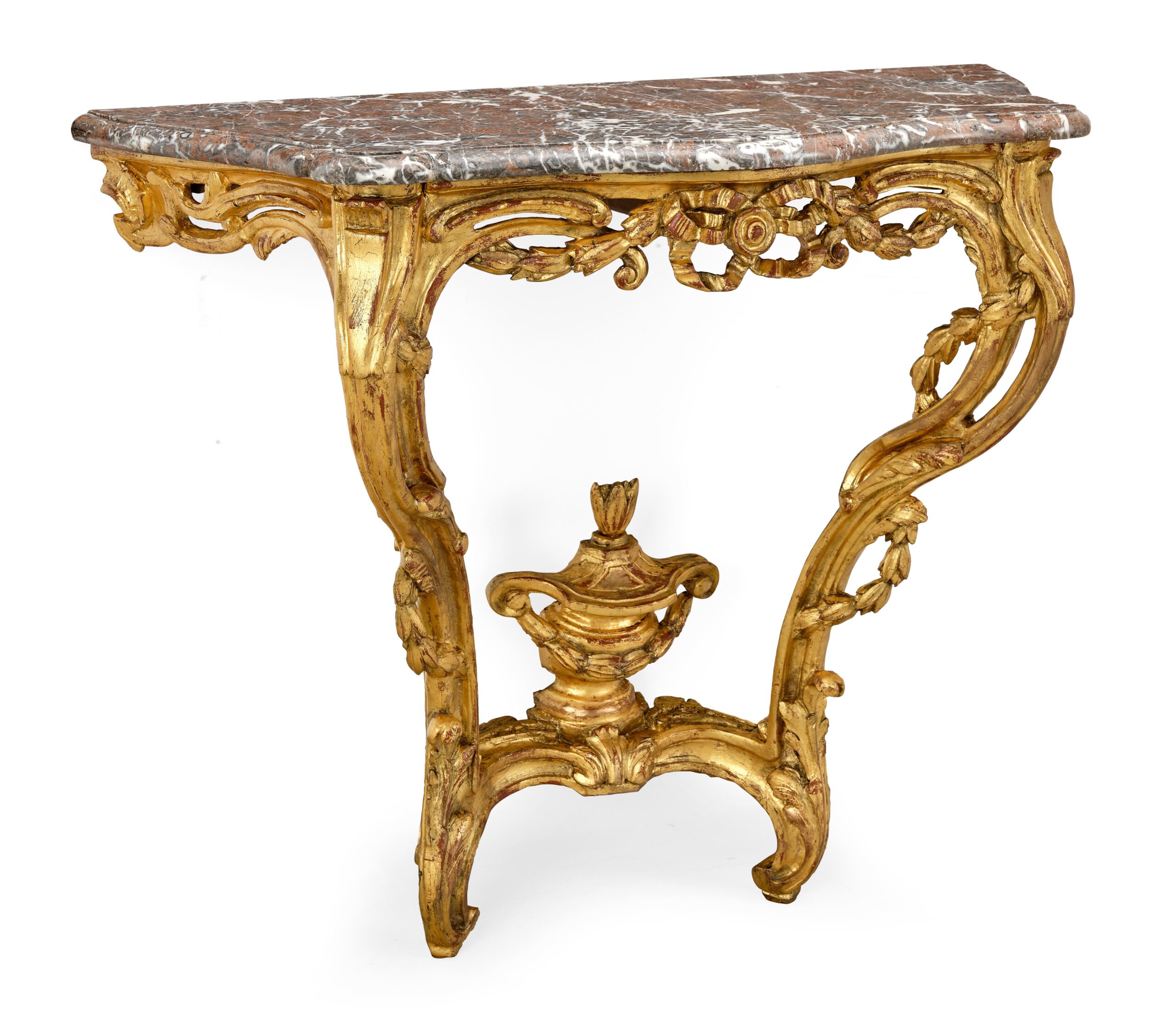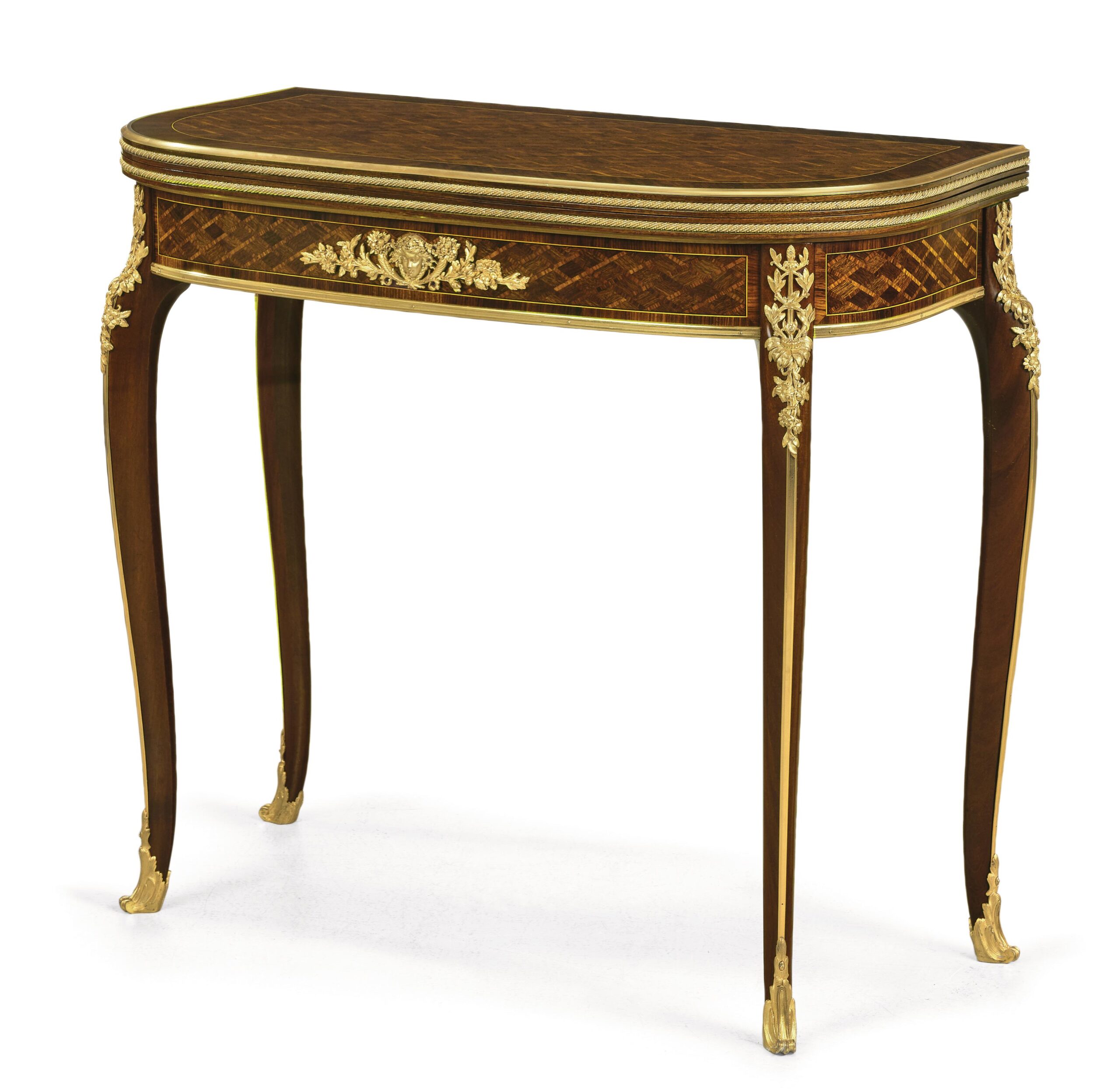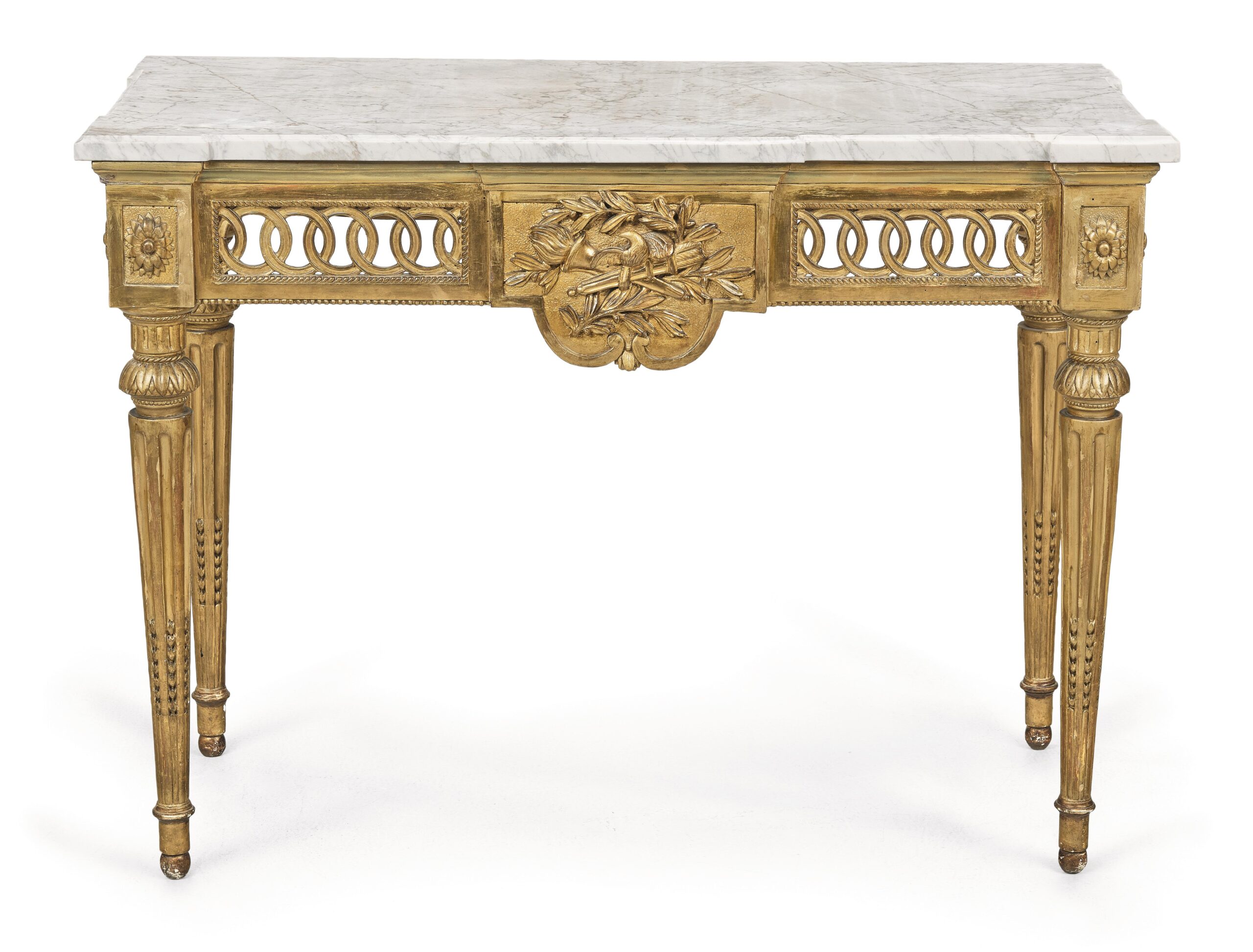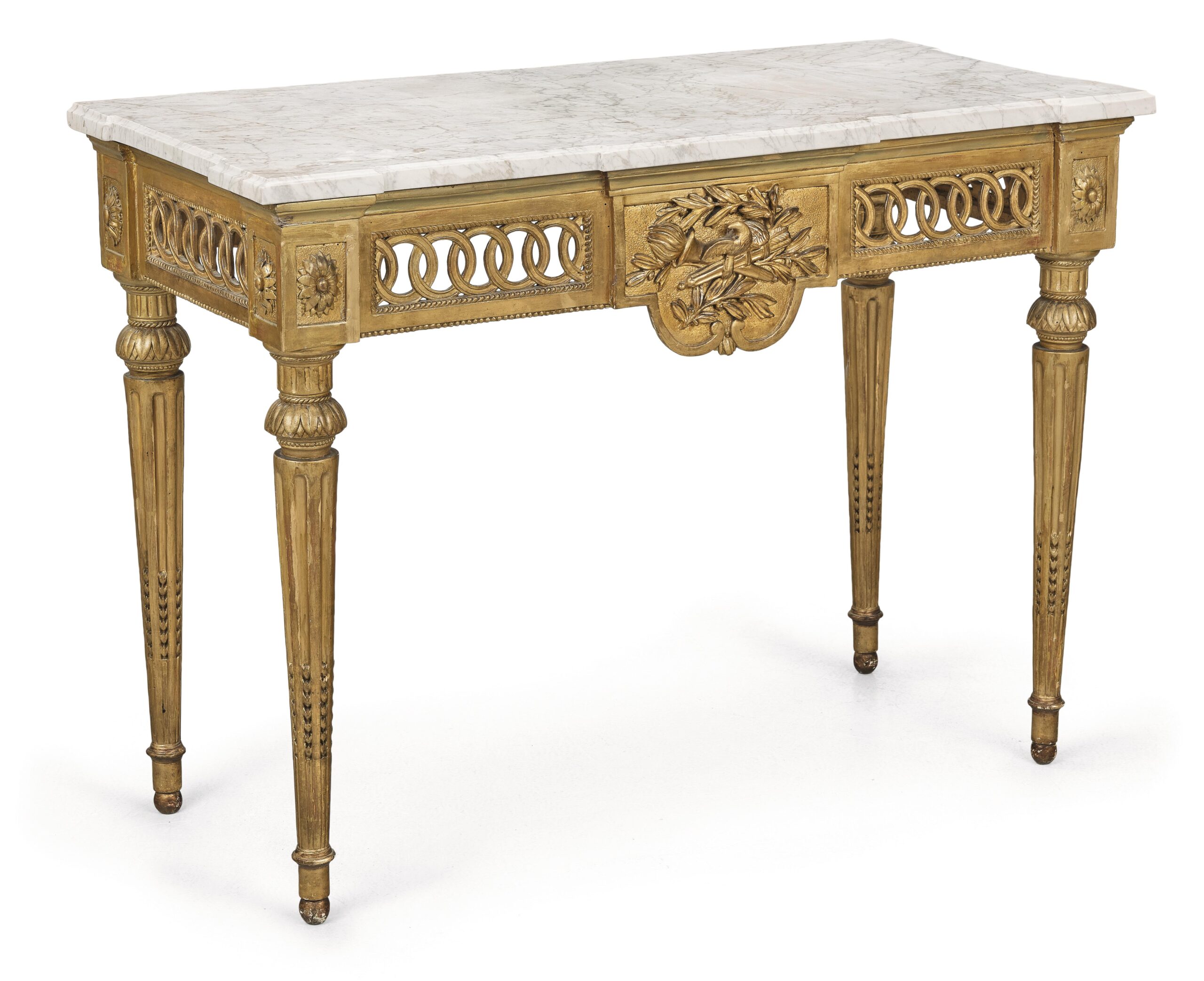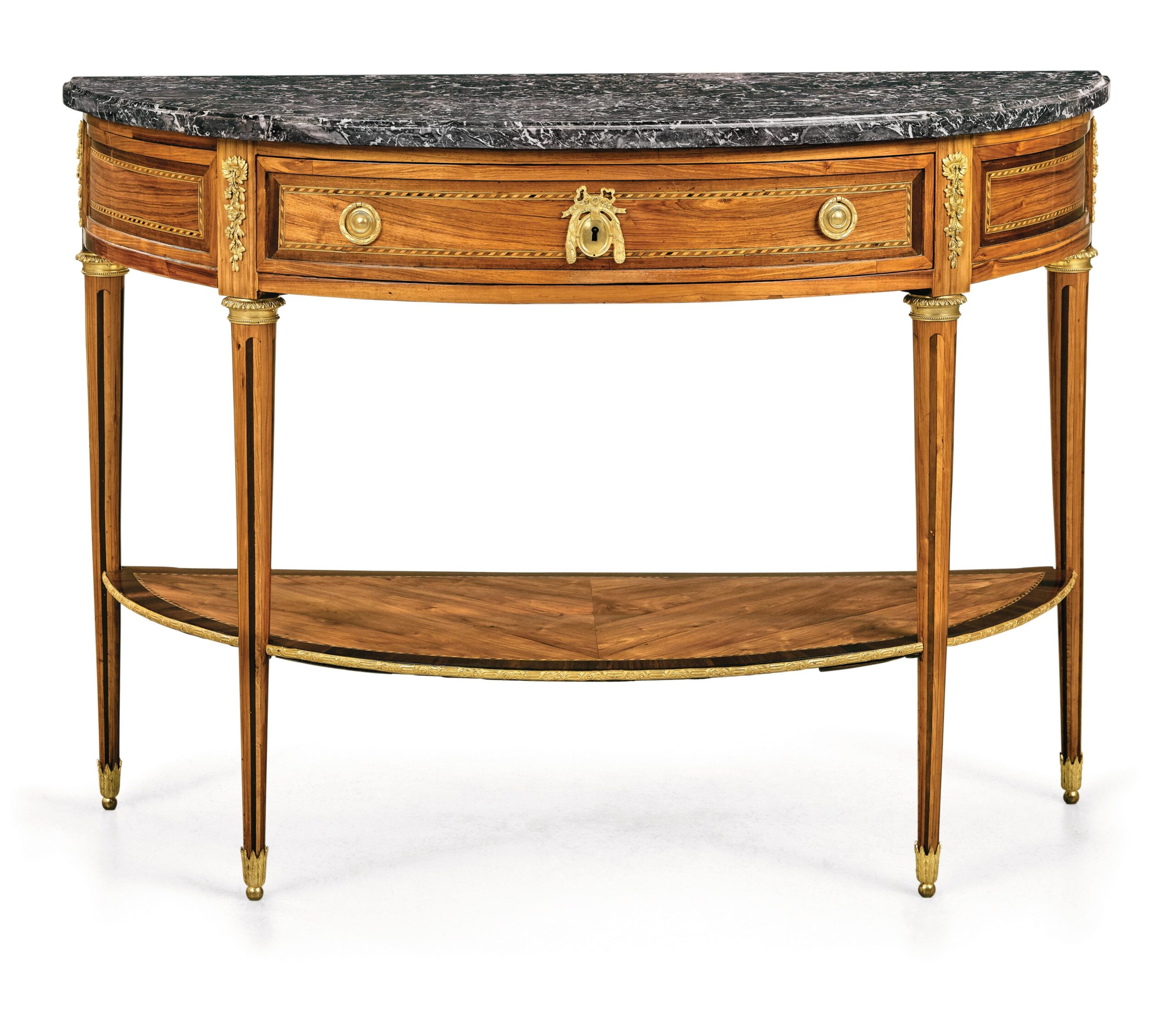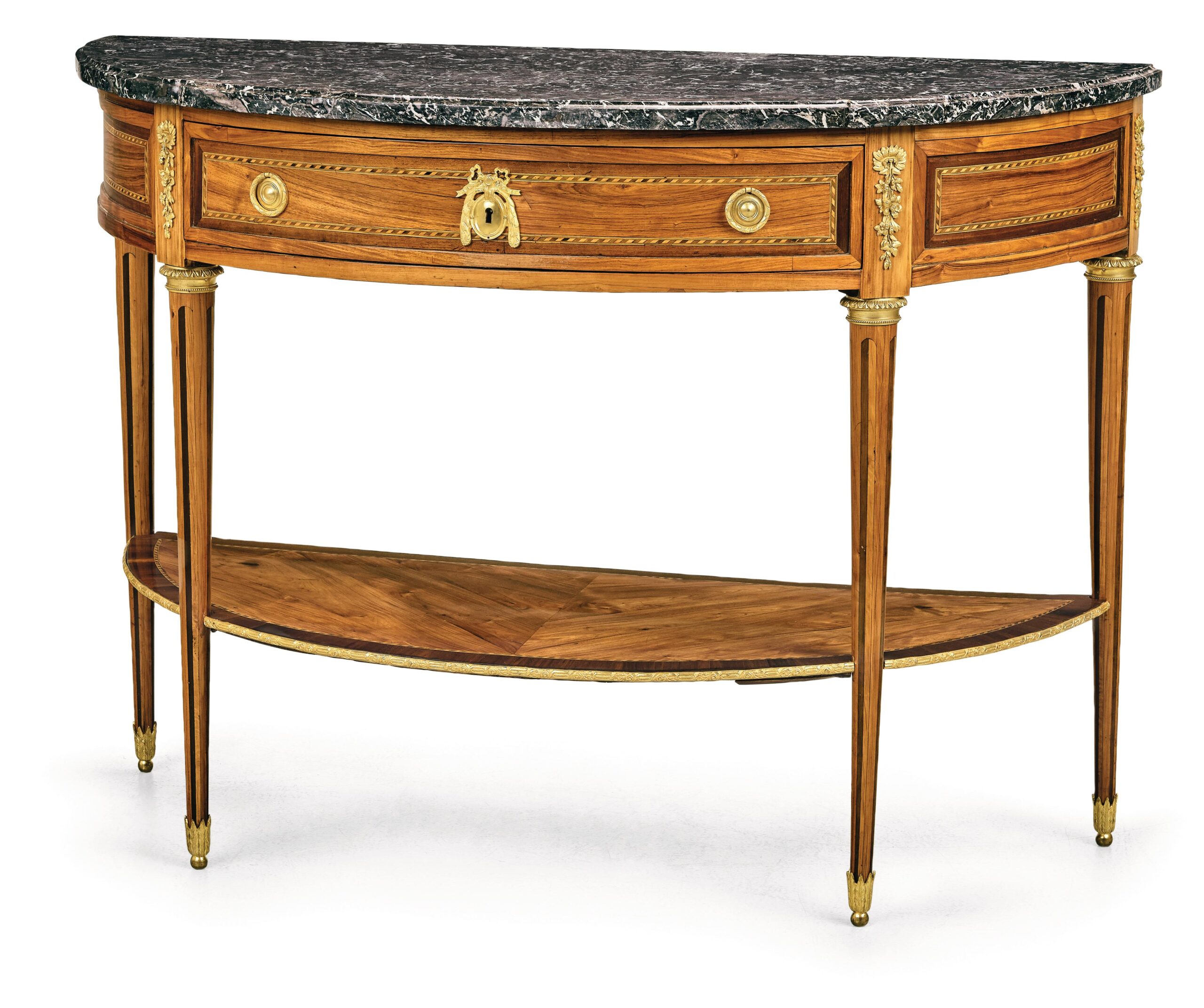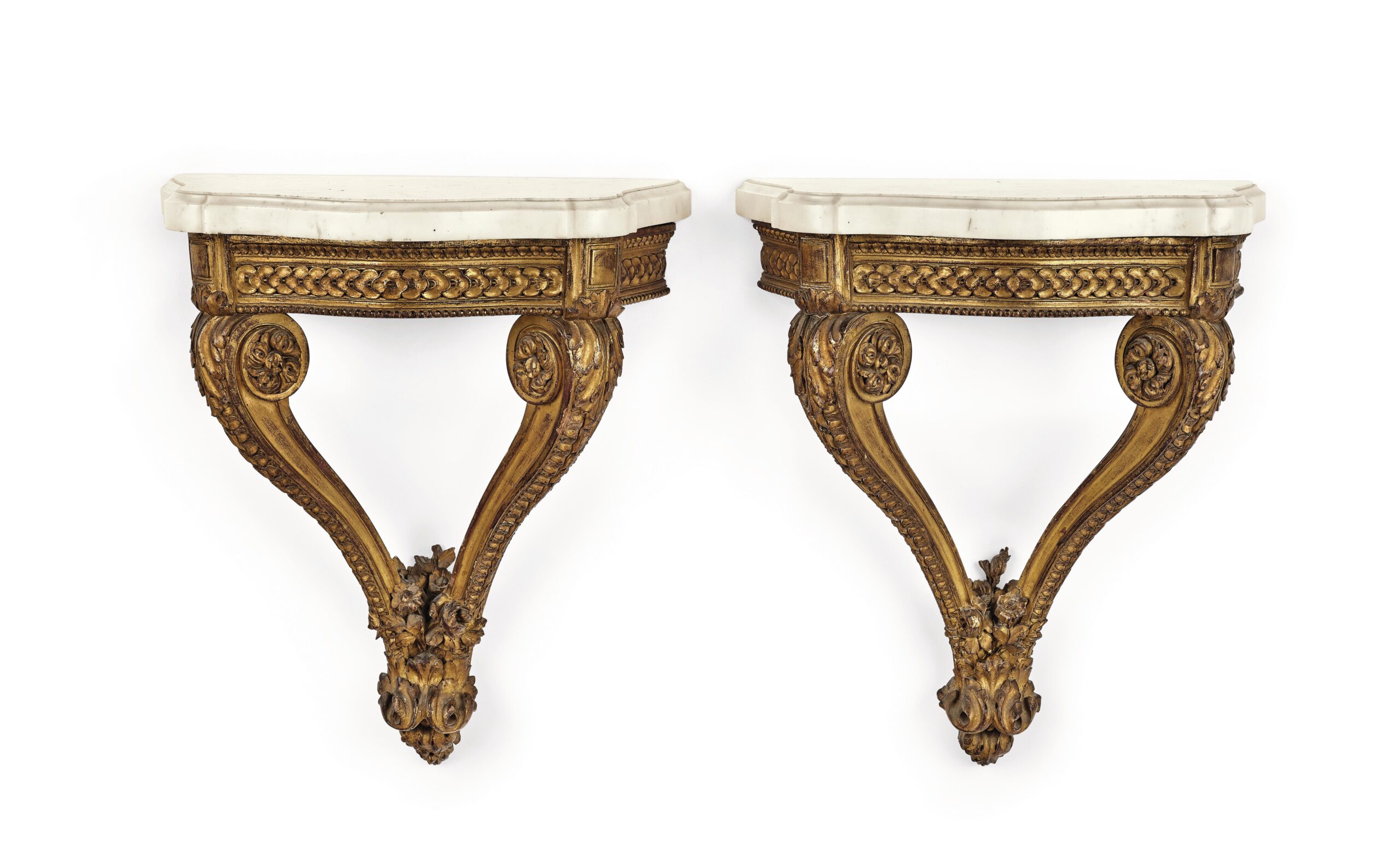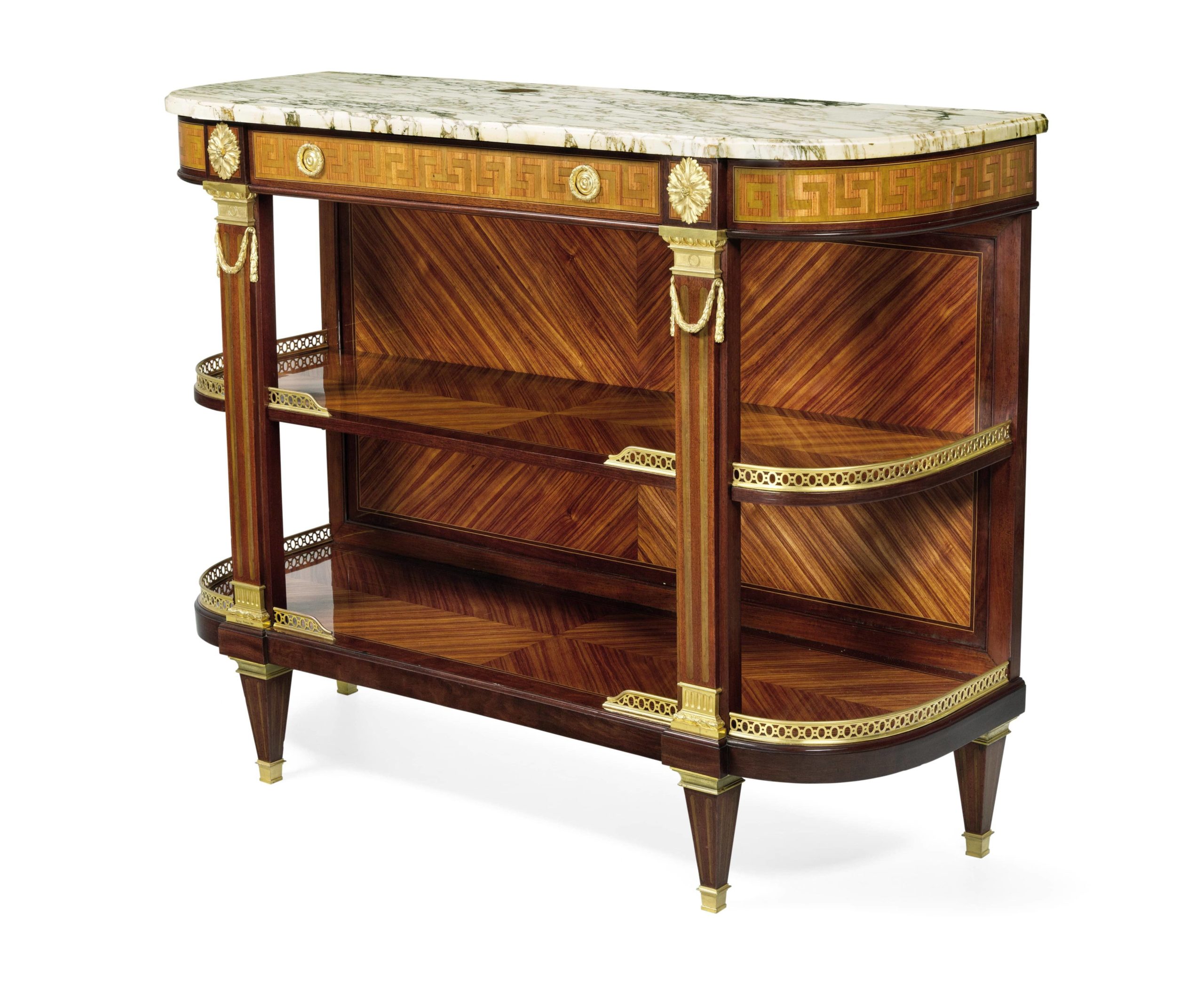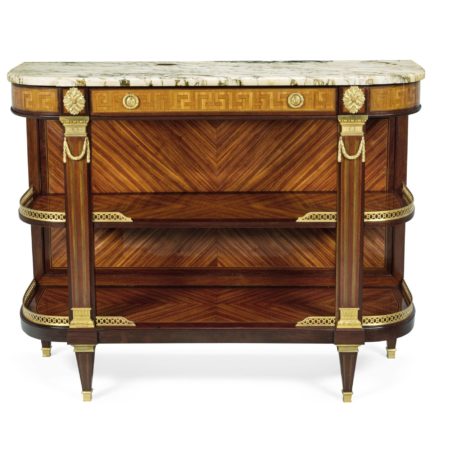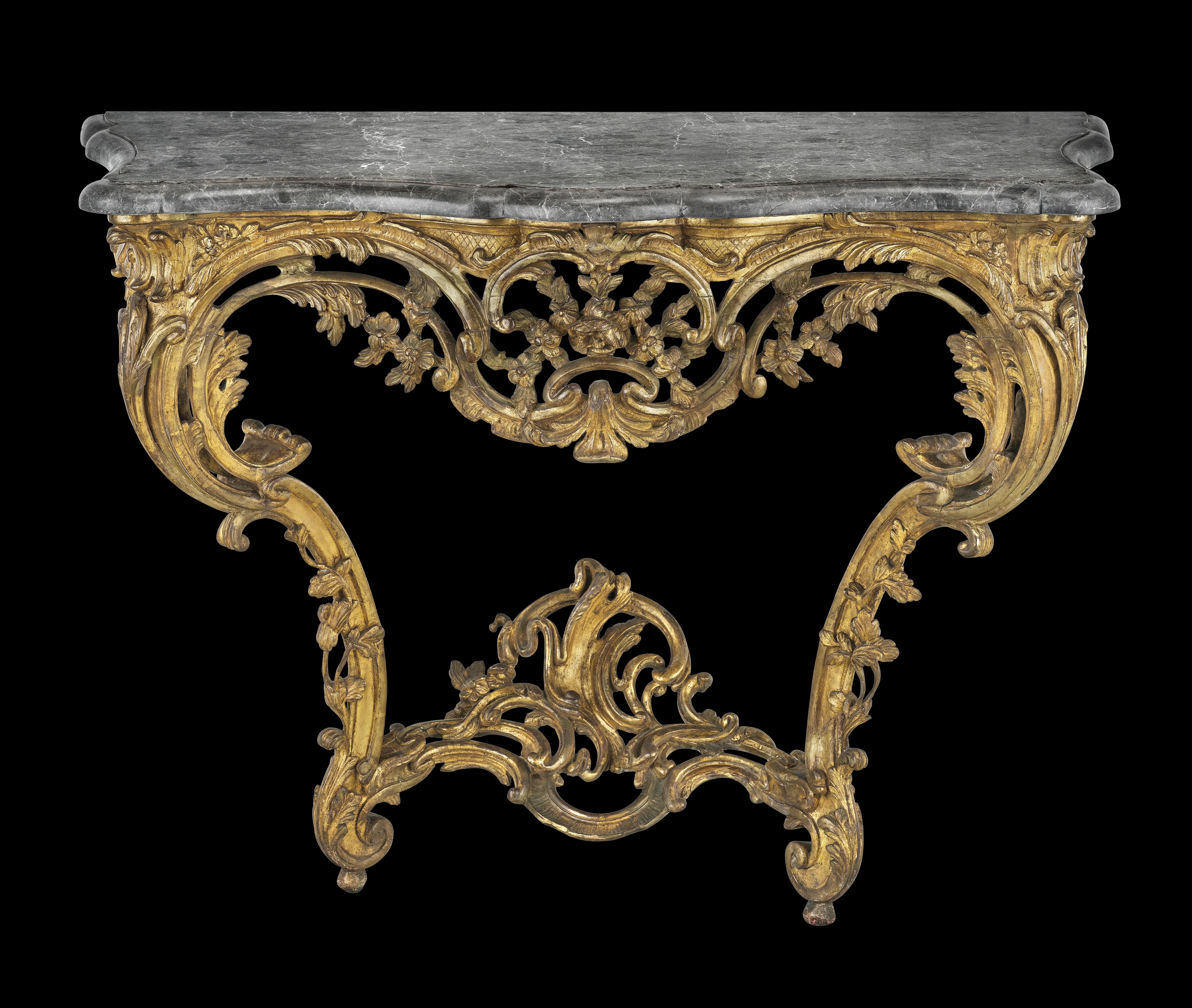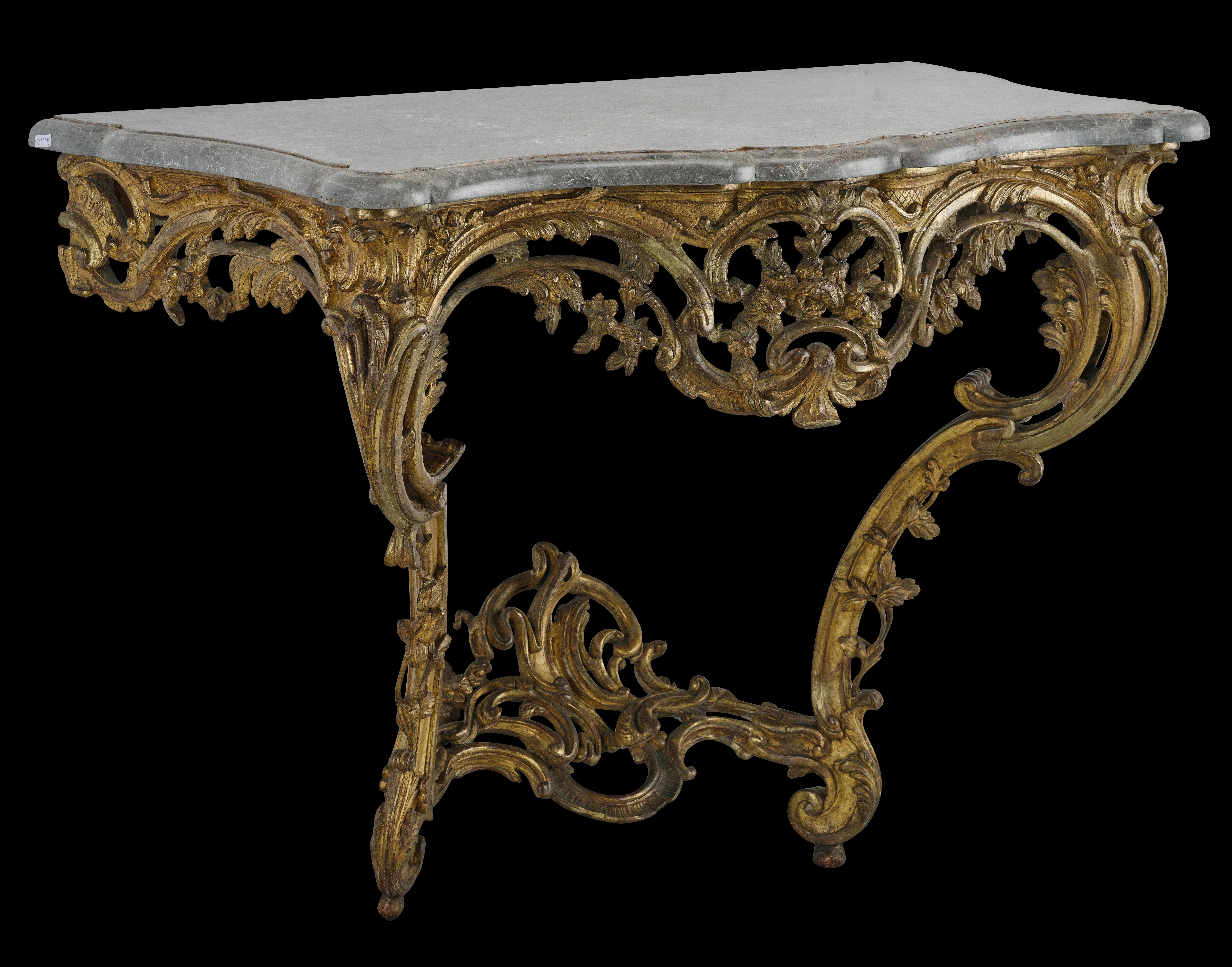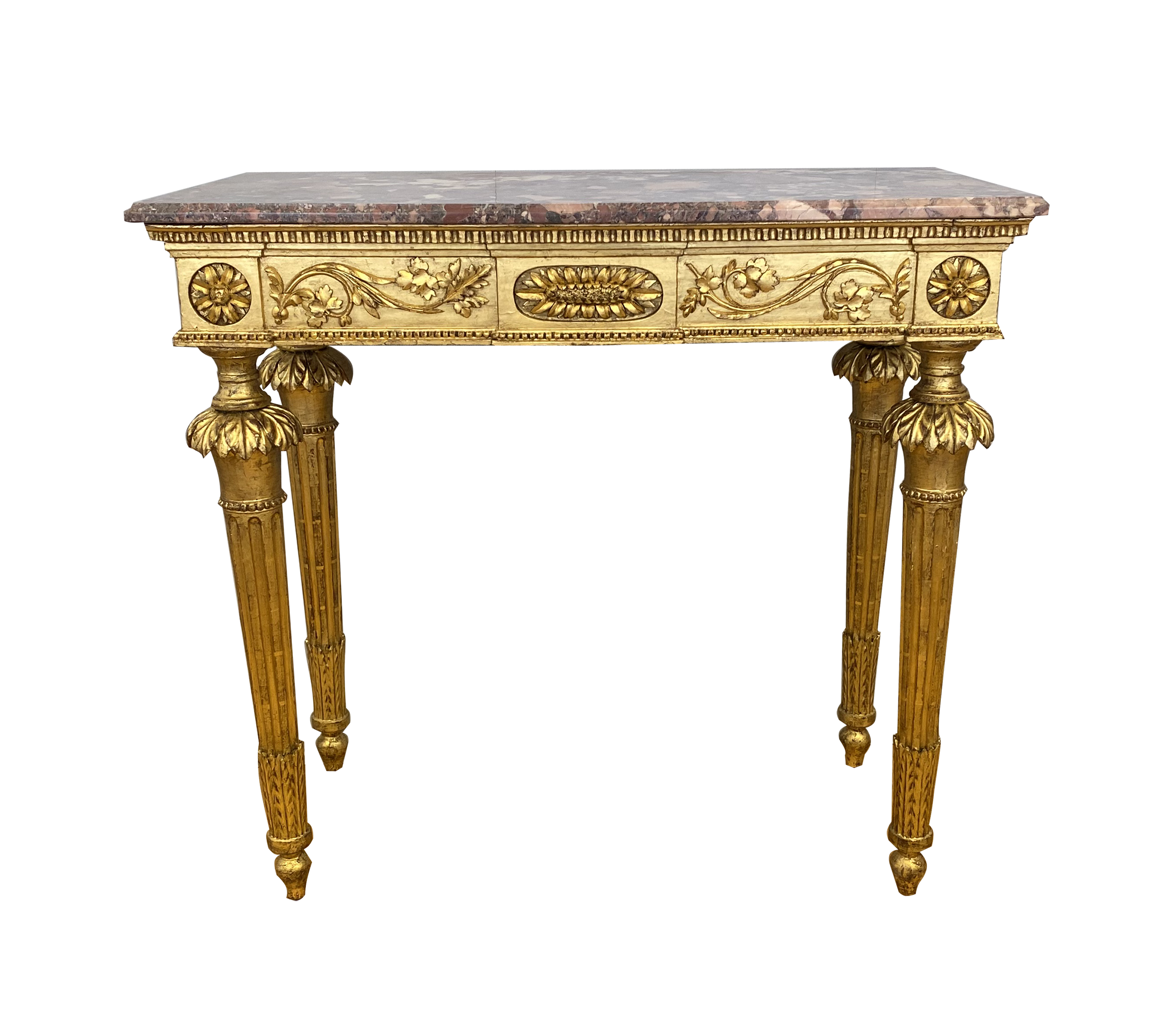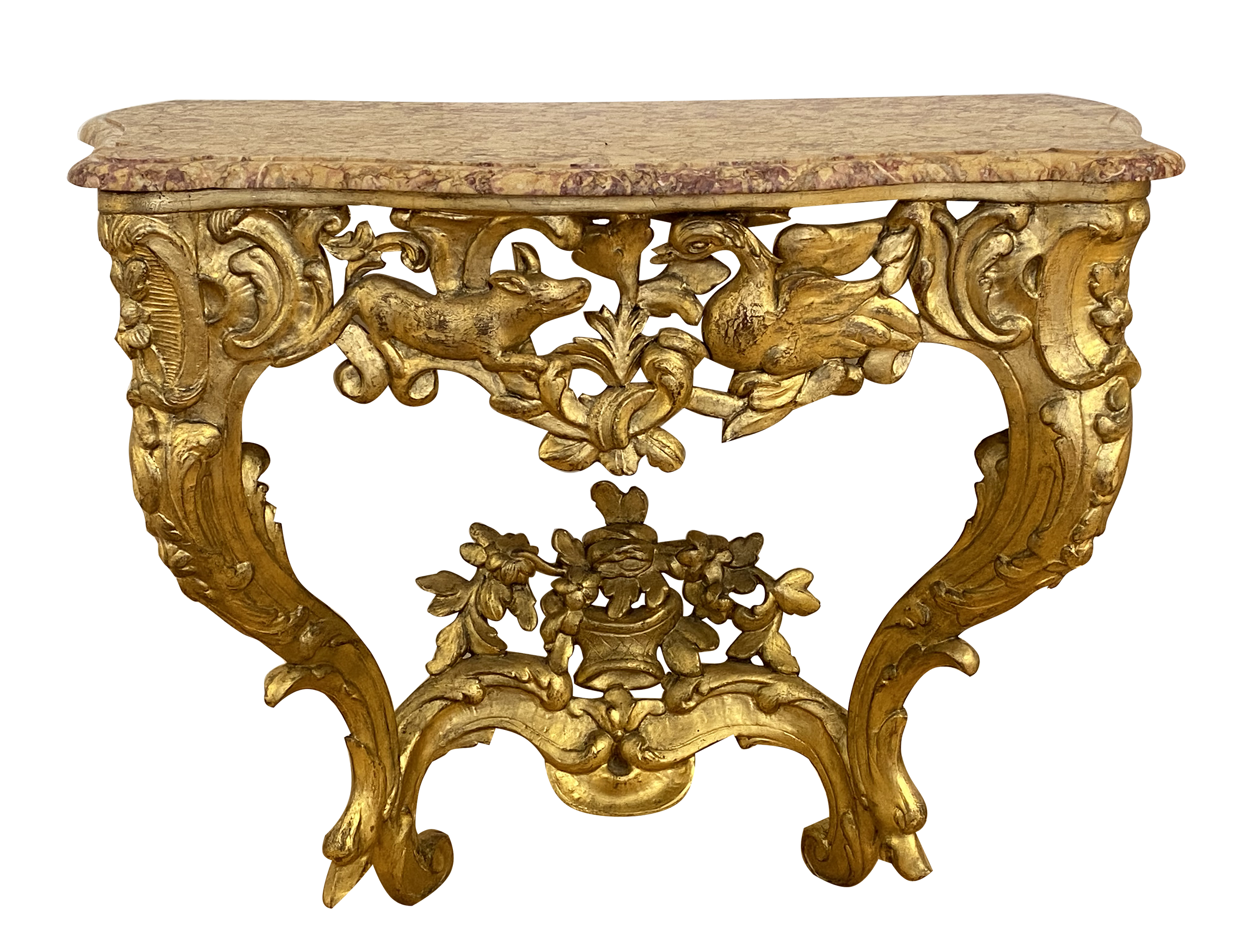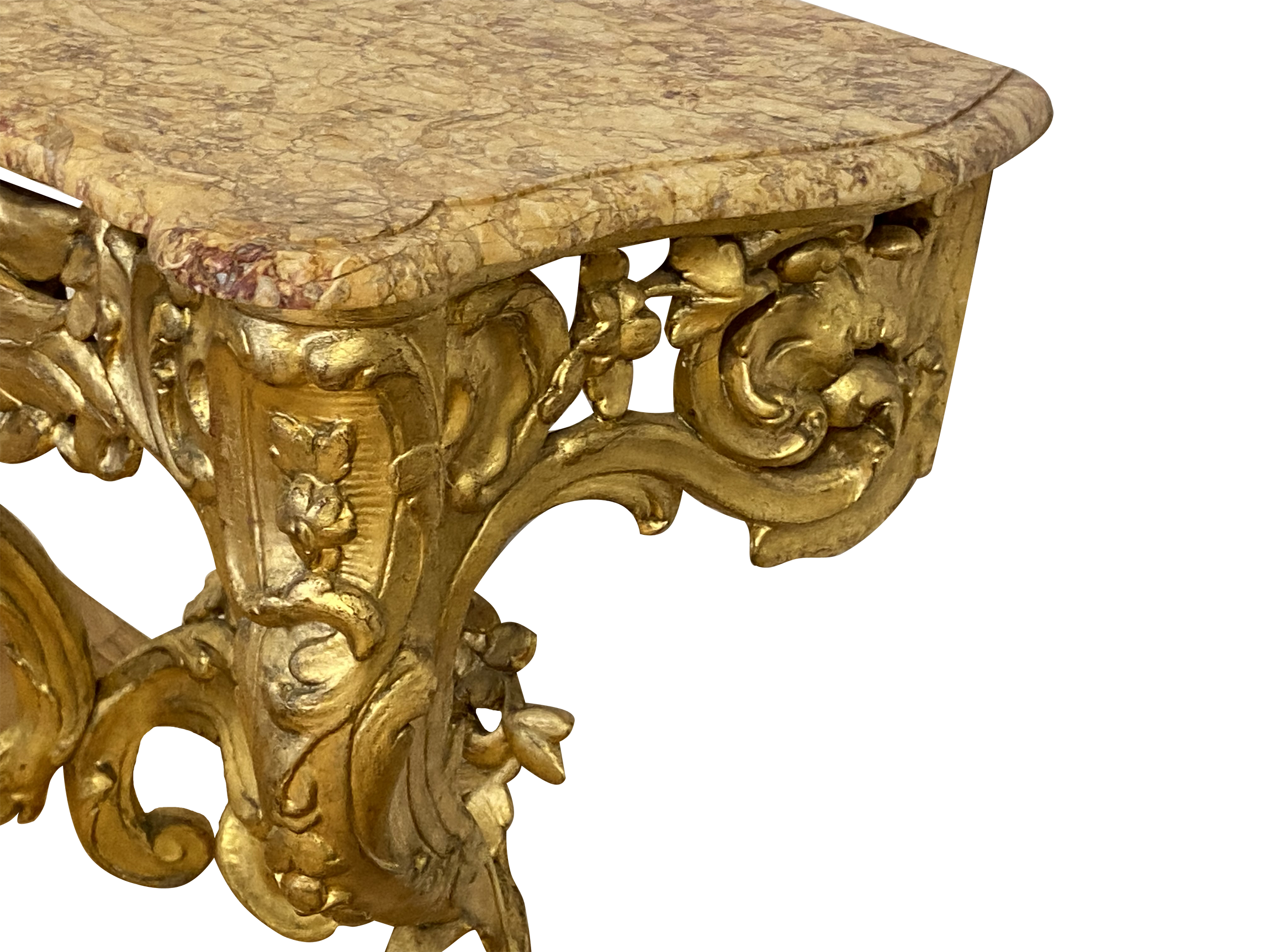Consoles
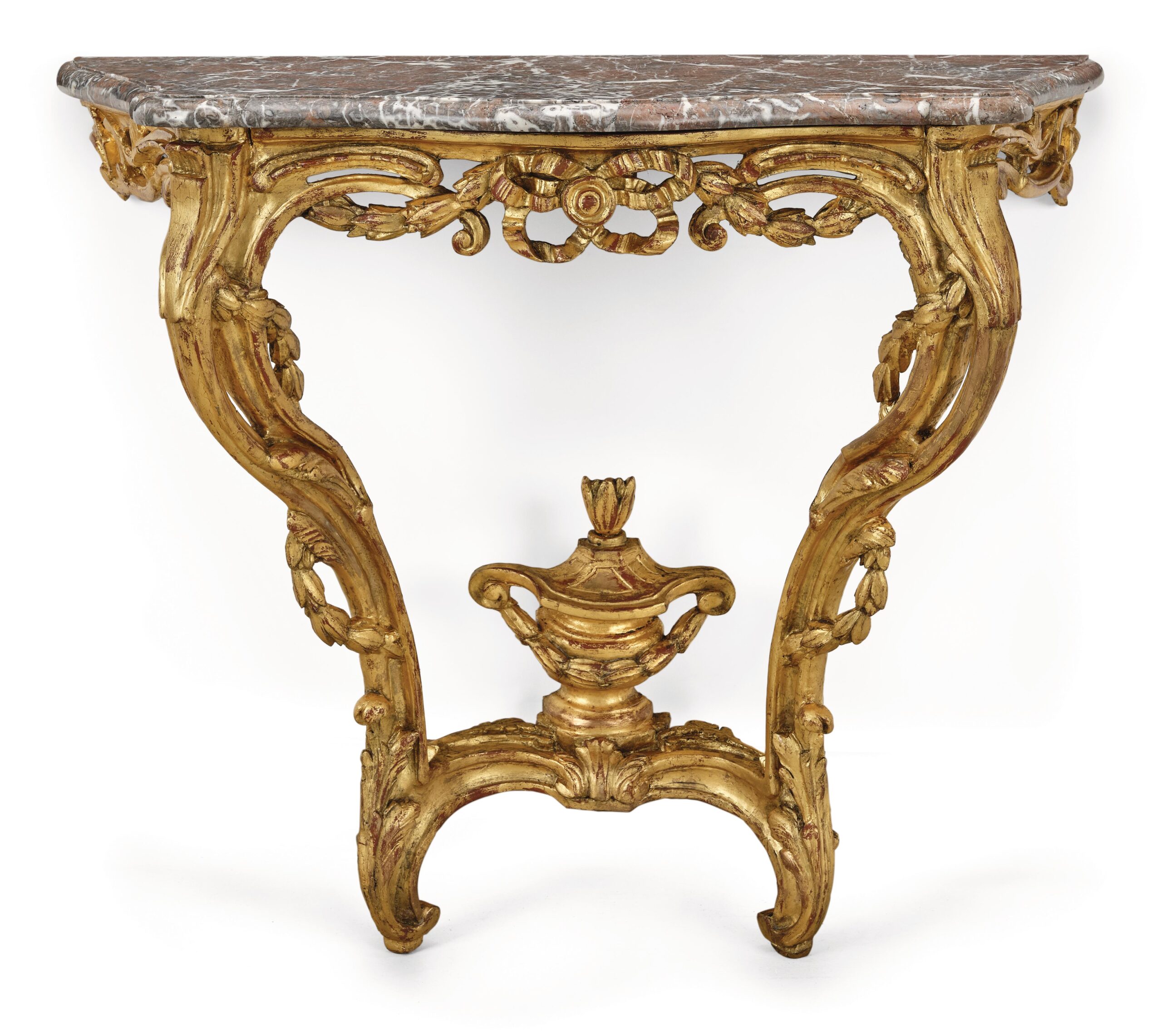
 €3,500.00
€3,500.00France, transitional style, c. 1770, curved, richly carved in the form of leaves, volutes, a decorative vase and a loop, openwork, painted gold, moulded marble top, 83 x 98 x 47 cm, restored condition, the painted decoration refreshed, structural elements in the frieze have been supplemented.
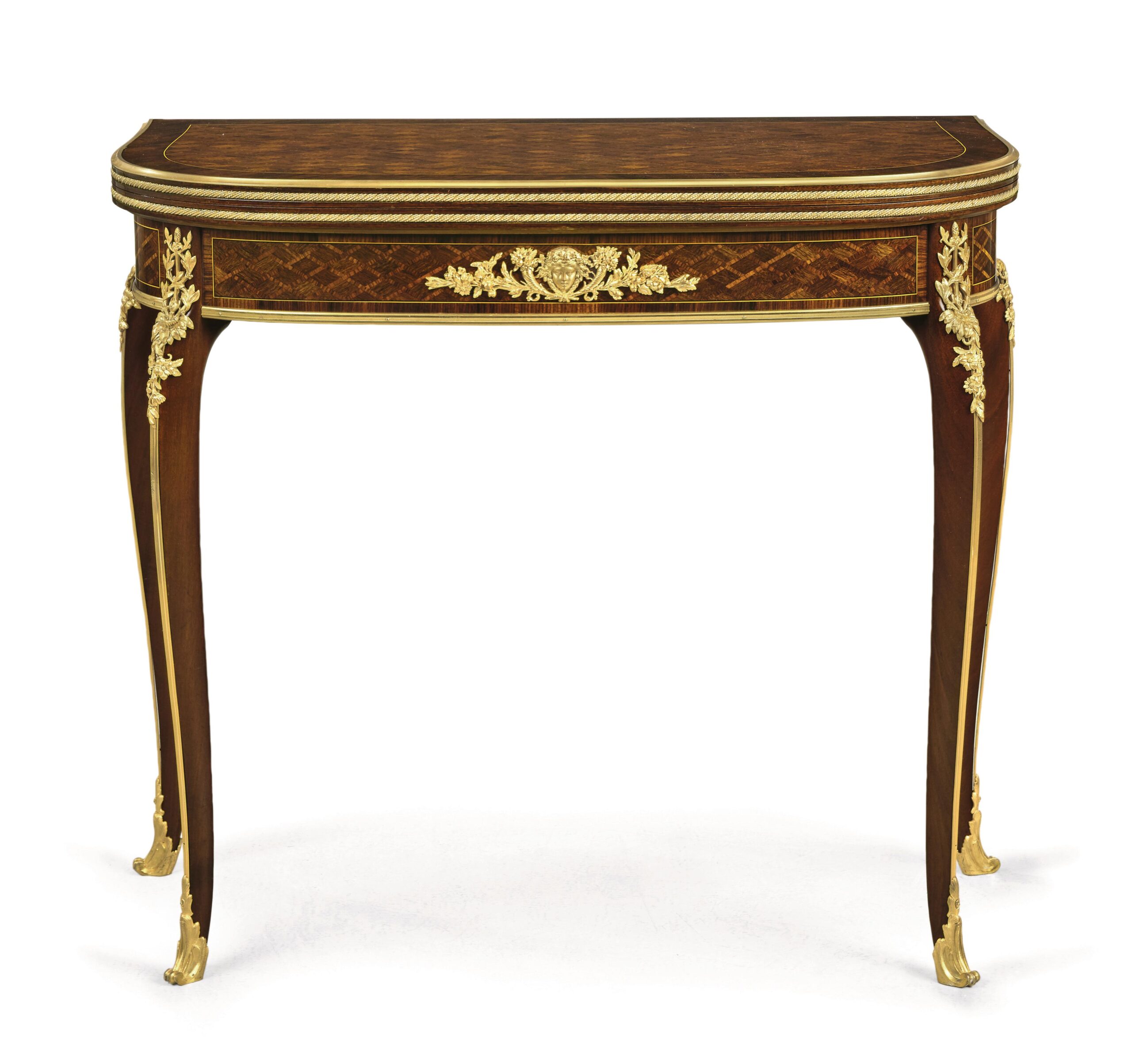
 Sold
SoldLate 19th century, by the French ebenist François Linke, (1855-1946), displayable oak frame, veneered with rosewood and mahogany as well as field- and lattice-marked, polished in traditional handcraft technique, gilded bronze fittings and ornamental strips executed and chased in highest quality, signed F. LINKE on a bronze, hinged top with interior felt covering, approx. 77 x 88 x 41 cm, beautiful professionally restored condition.
Subject to species protection (ASB)
François LINKE (1855-1946), one of the most important ebenists of the Parisian “Belle Epoque”, came from Pankraz (Bohemia / Austria-Hungary). After studying furniture making in Vienna for two years, he first went to Germany and then to France in 1875, where he worked as a laborer for the well-known cabinetmaker Antoine KRIEGER. After a short stay in Vienna in 1879, he returned to Paris to set up his own studio in 1881. Initially he produced for his former employer A. Krieger, but he quickly built up his own clientele thanks to his outstanding quality. His collaboration with the sculptor Léon Messagé, who was responsible for the design of the bronzes, was decisive for his future style and stellar career. Together they put together a collection for the Paris World Exhibition in 1900 that made Linke world-famous. He succeeded in creatively combining the classic Louis XV style with Art Nouveau. Works by François Linke are represented in all the world’s major museums and are highly sought-after on the art market.
 €5,000.00
€5,000.00Louis XVI period, c. 1780, various hardwoods and softwoods, conical fluted feet, openwork frieze, the front carved in the form of a bird, a torch, a quiver and foliage, gold-painted, partly bronzed, moulded marble top, 89 x 121 x 56 cm, in good overall condition with minor signs of age and use.
 Sold
SoldSo-called. Desserte, by the ebenist Jacques Birckle (master from 1764), Louis XVI period, c. 1780, oak frame, veneered with rosewood and amaranth and decorated with various precious woods, polished in traditional craftsmanship, one drawer, one intermediate compartment, profiled marble top, (Saint Anne) gilt bronze ornamental mounts and top border, stamped J BIRCKLE, 92.5 x 130 x 56 cm, beautiful restored condition.
 €7,600.00
€7,600.00- France Epoch Louis XV, Mid 18th century
- Various soft and hard woods, richly carved in the form of acanthus leaves, flowers and volutes.
- Openwork, gold-framed, constructive parts in the rear frame area completed
- Profiled marble top from later times
- Dimension: 85 x 113 x 58 cm
- Well-kept general condition with minor signs of age and use.
 €2,800.00
€2,800.00Gilded Louis XV console with animalistic attributes, France circa 1750. Curved softwood frame partly open worked. Richly carved in the form of flowers, volutes and leaves as well as a swan and a fox. Reworked gold leaf frame, profiled marble top. Dimensions: 87 x 99 x 49 cm. Good condition with small traces of use
Antique Consoles: Timeless Elegance for Classic Interiors
Consoles and console tables are exquisite pieces of furniture that trace their origins to domestic altars. Traditionally attached to or placed against walls, they evolved over the centuries into indispensable elements of opulent interiors. Antique consoles not only serve a functional purpose but also enhance the aesthetic appeal of any space with their timeless elegance.
The Evolution of Consoles Through the Centuries
By the 18th century, consoles had become an essential part of luxurious interior design, particularly in grand European homes. Italian artisans in Rome and Genoa produced some of the most stunning gold-framed consoles, while in France, Parisian craftsmen perfected the art, and in Germany, the city of Dresden became renowned for its intricate designs.
During the Baroque and Rococo periods, consoles featured elaborate carvings and were often gilded in gold leaf, exuding opulence and grandeur. With the arrival of Classicism and the Empire style, preferences shifted to more restrained and veneered models, showcasing fine woods and symmetrical designs.
The Role of Consoles in Antique Interiors
Under Louis XVI, the introduction of consoles-dessertes marked their use as functional dining room furniture, designed to hold serving dishes and decorative elements. While their primary purpose was ornamental, consoles became a key feature in salons, entrance halls, and dining rooms. They provided the perfect stage for displaying decorative objects such as:
- Elegant clocks
- Ornate candelabras
- Intricate vases
- Sculptural masterpieces
Consoles were often positioned beneath large mirrors to create a sense of space and light, enhancing the grandeur of any room.
Materials and Craftsmanship of Antique Consoles
Crafted from the finest materials, antique consoles were adorned with luxurious details, including gilded carvings, intricate marquetry, and exquisite inlays. Popular materials included mahogany, walnut, and rosewood, often complemented by bronze doré fittings or marble tops, adding an extra touch of sophistication.
Invest in an Antique Console for Your Home
Whether placed in an entryway to create an impressive first impression or used as an elegant accent piece in a living room or hallway, antique consoles bring a sense of history and refinement to any interior. Their timeless appeal ensures they remain highly sought-after by collectors and interior designers alike.
Explore Our Collection of Antique Consoles
Browse our carefully curated selection of antique consoles online or visit our Vienna showroom to discover the perfect piece for your space. Whether you’re looking for an ornate Baroque console or a sleek Empire-style table, our collection offers a range of options to suit your taste and interior style.
Add a touch of timeless elegance to your home with an antique console that embodies history, artistry, and exceptional craftsmanship.


